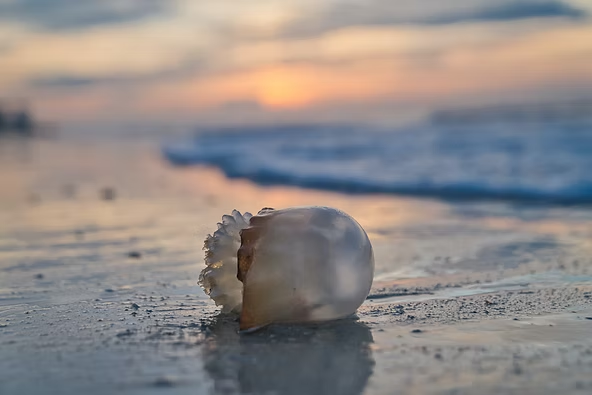By-the-Wind Sailor Jellyfish: Life at Sea and Death on Shore
The by-the-wind sailor jellyfish (Velella velella) drifts through the ocean like a carefree tourist on a cruise ship, feeding on a buffet of plankton and small fish. With a rigid sail above the water and purple tentacles below, these jellies ride the wind to new feeding grounds. Thriving colonies can include millions of individuals, floating together across vast stretches of ocean.
The Stranding Phenomenon
Life is good until the wind shifts. When seasonal currents and breezes push entire colonies toward land, thousands of jellyfish end up stranded on beaches worldwide. Once ashore, they quickly dehydrate, leaving behind what scientists call a “crunchy carpet” of corpses. While small-scale strandings are relatively common, some events are far more extreme. For example, in 2006 on New Zealand’s west coast, millions of jellies covered the shoreline in a single mass die-off.
Investigating the Mystery of Mass Die-Offs
To understand why some strandings become so massive, researchers analyzed 20 years of observations reported through the Coastal Observation and Seabird Survey Team (COASST). This citizen science program monitors beaches along the U.S. west coast, from California to the Arctic, documenting unusual wildlife events, including jellyfish strandings.
Nearly 500 reports of Velella strandings were recorded across almost 300 beaches. The largest die-offs occurred between 2015 and 2019, when stranded jellies blanketed more than 1,000 kilometers of coastline. These years aligned with a major marine heatwave known as “the blob,” which raised Pacific surface temperatures to unprecedented levels.
Climate Change and Jellyfish Blooms
While warming waters harmed many marine animals — including seabirds, whales, and sea lions — the blob may have temporarily boosted sailor jellyfish populations. Warmer seas allowed species like northern anchovies to spawn longer, providing more food for the drifting jellies. With abundant prey, Velella populations surged, only to be carried onto beaches when seasonal winds shifted.
In this way, climate-driven changes created a paradox. The same warming that destabilized marine ecosystems and triggered widespread die-offs of many species may have fueled record jellyfish blooms, which then ended abruptly in mass strandings.
Implications for Ocean Health
These findings highlight the complex ways climate change reshapes marine life. For the by-the-wind sailor jellyfish, favorable conditions at sea can quickly turn fatal once winds change direction. On a larger scale, the study underscores how shifts in temperature, food supply, and ocean currents interact to produce sudden ecological disruptions. Understanding these dynamics is essential for predicting how marine ecosystems will respond as the oceans continue to warm.
Ultimately, the story of the sailor jellyfish is both fascinating and cautionary — a reminder that climate change alters not just individual species, but the entire balance of life in the oceans.

